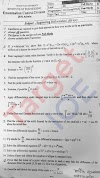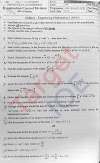Course objective:
Applied Mechanics is the branch of physical science which deals with the laws of forces and its effect on bodies. Sir. Issac Newton used the word “mechanics” for the science which deal with machines. This course has a systematic study of different laws and principles of mechanics along with their applications to solve engineering problems.
From Chapter 1 - 3 marks
From Chapter 2 - 8 marks
From Chapter 3 - 12 marks
From Chapter 4 - 12 marks
From Chapter 5 - 4 marks
From Chapter 6 - 13 marks
From Chapter 7 - 8 marks
From Chapter 8 - 10 marks
From Chapter 9 - 10 marks
Note:- This marks may be changed
1) Introduction ( 2h | 3 Marks)
- Definitions and scopes of Applied Mechanics
- Concept of Rigid and Deforming body
- Fundamental concepts and principles of mechanics: Newtonian Mechanics
2) Basic concept in statics and static Equilibrium ( 4h | 8 Marks)
- Concept of particles and free body diagram
- Physical meaning of Equilibrium and its essence on structural
- Equations of Equilibrium in two dimension
3) Forces acting on particle and rigid body ( 6h | 12 Marks)
- Different types of forces: Point surface traction and body forces - Translation force and rotational force
- Resolution and composition of forces
- Principle of Transmissiblity and Equivalent forces
- Moments and couples
- Resolution of a forces into forces and a couples
- Resultant of forces and moments for a system of forces
4) Center of Gravity, Centroid and Moment of Inertia ( 6h | 12 Marks)
- Concept and calculation of center of gravity and centroid
- Calculation of second moments of area / Moments of inertia and radius of gyration and relevant uses
- Use of parallel axis theorem
5) Friction ( 2h | 5 Marks )
- Laws of friction, static and dynamics coefficient of friction, angle of friction: Engineering example and uses
- Calculation involving friction in structures: examples as high tension friction grip bold and its free body diagram
6) Analysis of Beams and Frames ( 9h | 13 Marks )
- Introduction to structures: Discrete and Continuum
- Concept of load estimating and support idealizations:
- Use of beams frames in engineering: concept of rigid joints/distribute loads in beams/frame
- Concept of statically / Kinematically determinate and indeterminate beams and frames
- Calculation of axial forces, Shear forces and bending moments for determinate beams and frames
- Axial force, shear force and bending moments diagrams and examples for drawing.
7) Analysis of Plane Trusses ( 4h | 8 Marks)
- Uses of trusses in engineering: concept of pin joints and joint loads in trusses
- Calculation of member forces of truss by method of joints
- Calculation of member forces of truss by method of sections
8) Kinematics of Particles and Rigid Body (7h | 10 Marks )
- Rectilinear kinematics: Continuous motion
- Position, velocity and acceleration of a particle and rigid body
- Determination of motion of particle and rigid body
- Uniformly rectilinear motion of particles
- Uniformly accelerated rectilinear motion of particles
- Curvilinear motion: Rectangular components with examples of particles
9) Kinetics of Particles and Rigid Body: Force and Acceleration ( 5h | 10 Marks )
- Newtons's second law of motion and momentum
- Equation of motion and dynamics equilibrium
- Angular momentum and rate of change
- Equation of motion - rectilinear and curvilinear
- Rectangular: Tangential and normal component and polar coordinates: radial and transverse components






0 Comments